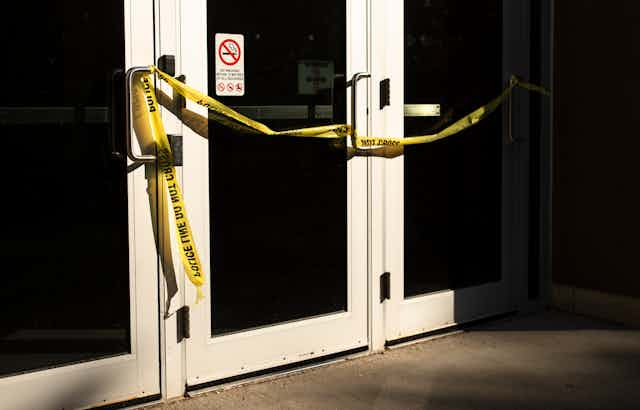In the wake of the recent stabbing attack on a University of Waterloo professor and two students in a philosophy of gender course, we need to talk about the profound power words have to shape our world.
We are both professors at the University of Waterloo who focus on various aspects of gender and language in our research and teaching.
In her book, Call Them By Their True Names, journalist and author Rebecca Solnit argues that we are presently in a crisis of language where words have lost their meaning in a sea of misinformation and inflamed debates. Her response is that we all must be careful and precise with the words we use in order to “oppose the disintegration of meaning.”
In this spirit we will be very precise in our language here: the continued patterns of violence both online and offline against women, racialized, disabled, queer and gender nonconforming people are forms of stochastic terrorism and need to be named as such.

What is stochastic terrorism
At its core, stochastic terrorism is public demonization of a group which incites random violence against that group. Crucial here are the words public, demonization and violence. They work together to silence people either by threat of violence or through violence itself.
When a group of people are publicly and repeatedly demonized, they are dehumanized for the benefit of others. This demonization and distancing is crucial for inciting violence. It makes violence toward certain people, or those expressing certain ideas, more palatable. It distances those enacting the violence from the true horrors of their actions.
When it comes to gender-based violence such demonization is hardly new. It was used to target women and others who did not conform to religious dogma in medieval and early modern witch trials.
More recently, the demonization of women has been a staple of so-called incel doctrines that have informed other acts of violence including the Isla Vista shootings in 2014 and the Toronto van attack in 2018.
Social media is awash with influencers like Andrew Tate who spread misogynistic rhetoric to millions. All this combines to create a situation where gender-based violence becomes more likely.
Read more: Yes, the incel community has a sexism problem, but we can do something about it
Spreading hate has real consequences
This hatred is spread through public conversations, often on social media platforms that do not adequately regulate hate speech or protect the most vulnerable recipients of that hate speech.
When such ideas spread rapidly and easily in online spaces without consequence it allows them to multiply and gain validation. This combination of widespread, normalized, publicly accessible hatred and dehumanization is central to the forms of violence we see erupting across spaces currently, including in our spaces of learning.
As women scholars who came of age in the shadow of the École Polytechnique massacre, we are well aware of how gender-based violence makes a lasting impact on how we experience and move in the world. The murder of 14 women by a gunman motivated by a hatred of feminists sent a very direct message to Canadian girls and women who witnessed the horror and its aftermath.
At a time when both of us were planning out our post-secondary studies, the message we heard was: you are not welcome in spaces of learning and the threat of violence will always be present. For us and others of our generation, this formative experience served as a basis for many of our feminisms.
This week, the immediate thoughts and feelings we experienced after the violent attack on members of our university community were all too familiar. They reminded us again that the threat of violence for daring to stand in a classroom and speak is ever-present.

University classrooms can be transformative
Being precise with language allows us to also name what could be. In her 1993 Nobel Lecture, American novelist Toni Morrison defined language as something that delimits the possibilities of our world. Language can oppress and do violence. However, when it is used collaboratively in good faith, it becomes a way to open us all to a better world.
Universities embody this double-edge. They can be sites of violence and silencing that has shaped us in profound ways. They are also sites of risk in choosing to speak at all, in sharing ideas that are new and untested, and in the sense that by inviting new perspectives we risk our well-worn certainties and challenge our fundamental assumptions.
But that is how places of learning become sites of transformation and liberation. This specifically is what we want for our students, now and in the future. The risk is present, but so too is the promise of change. And so we will continue to teach and share insights on issues of gender within our classrooms because the sharing of knowledge is what universities are intended for.
There has always been rhetorical and violent backlash when people express new ideas and challenge established norms. Women, queer, racialized and gender nonconforming students and professors are vulnerable to the violence of what is considered the norm. It is disingenuous and dangerous to pretend it is otherwise.
We must name things for what they are, acknowledge the ways that we are vulnerable, and confront the continued harm done by the unchecked and dehumanizing public forums of the internet. We hope the ongoing threat of violence does not deter younger generations from being curious, examining the world, and sharing their visions for the future.
What we need to do as a public community both inside and outside universities is support our youth by naming hatred and violence for what it is. In doing so, we can expose the consequences of the demonization of others and the weaponized use of language.

